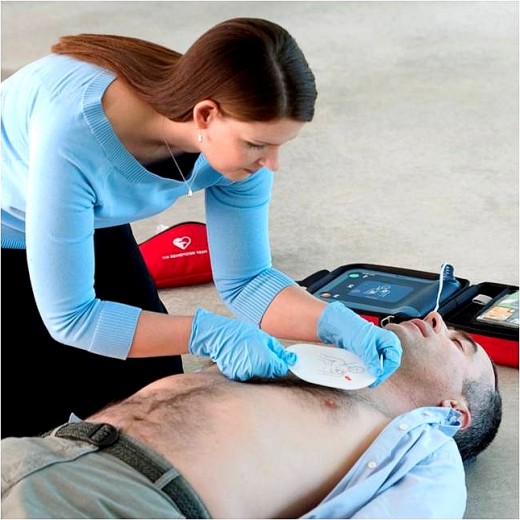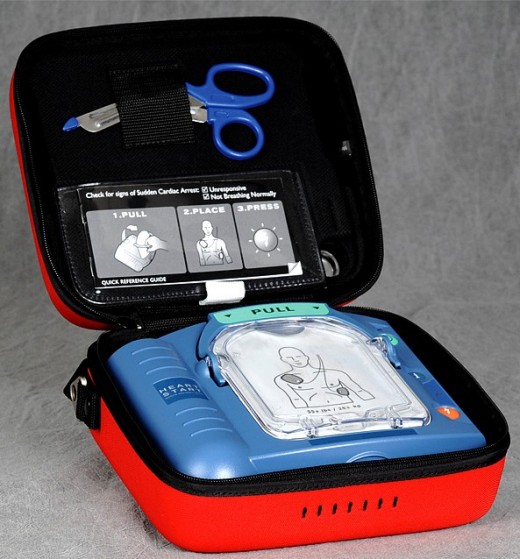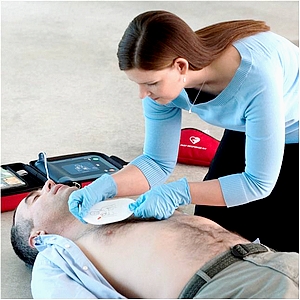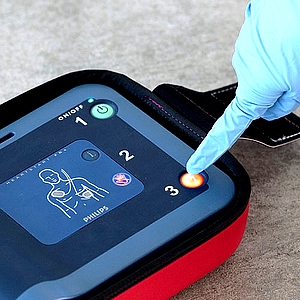Automated External Defibrillator - How to Choose and Use an AED
More and more enterprises and public agencies have installed an Automated External Defibrillator (AED) apparatus in their offices.
Many families are also considering buying and installing them in their own homes, when a family member or visitors, are at risk of cardiac arrest or fibrillation.
An AED is an electrical device with pads that can be positioned on the chest of a person suspected of having a cardiac arrest. It senses the heart's beat and rhythm during an episode of cardiac arrest and, if required the device sends an electric shock to the paddles to get the heart beat going again.
In an crisis, the ACD crucially makes all the correct decisions and responses for you, and this helps prevent incorrect usage when shocks are applied to normally beating hearts. This can be very dangerous and could itself makes things worse. The AED also produces step-by-step voice directions to help a user through the defibrillation process. It also provides ongoing monitoring of the heart beat once it has been re-established while you mau be waiting for the ambulance to arrive.
In summary, the information that accompanies the AED device provides an explanation of how somebody can test for crucial breathing signs and pulse rate and how to place the electrode pads in the correct position on the person's chest. There is also a video that people who share premises with persons at risk can go through well before an event occurs. You should watch and replay the video when you first purchase the apparatus, and at regularly intervals thereafter as a refresher for maintaining your knowledge about how to use the device.
Similarly the information supplied with the AED provides an excellent up date about the correct procedure for to Cardio Pulmonary Resuscitation (CPR).





Detailed Description of How the AED Device Works
The device works through a set of pads that are placed in correct locations on the chest. Once the device is switched on, the AED automatically checks the subject's heart rhythm and automatically works out if a shock is needed to reset the correct beating of the heart. If shocks are required, the machine tells the user to stand back and when all is clear asks the user to push a button to send the shock to the paddles. The AED also provides users with a step by step guide to how to conduct CPR, which is very useful.
The unit should not be seen as a substitute for calls to emergency response teams, which should be the first thing you or someone else does in an emergency. The AED device is only designed to fill in the gap between when the emergency happens and the response team arrives. This is a very critical time in terms of saving the life of someone who has cardiac arrest. The automated defibrillation units monitors the patients heart and can make repeated responses until emergency crews arrive and take control.
Cardiac arrest happens when the heart's inbuilt electrical stimulation malfunctions and becomes erratic. The heartbeat become chaotic (ventricular fibrillation) or can too fast (ventricular tachycardia). Because of this chaotic beat pattern the heart may stop pumping blood to the brain and the rest of the body risking death and injury. The brain and the other vital organs may rapidly become starved of oxygen carries in the blood. Many people with these heart problems die before emergency help arrives and many that survive have permanent brain damage. The faster the heart's normal beating rhythm is restored the better, and every minute of delay increases the risk.
Cardiopulmonary resuscitation (CPR) is a vital step in the emergency lifesaving process as it keeps some blood flowing and oxygen being supplied to your brain, heart and other vital organs for a small period of time until help arrives. It applies to heart failure and slow heart beats. It is quite distinct from heart fibrillation and the emergency response complements it. Remember to start CPR before you engage the AED, and to recommence CPR again after the shocks have been delivered if CPR is still needed.
If someone's heart undergoes fibrillation and an AED device is available someone could grab it, connect it to your chest and get the device to check the heart beat and rhythm. If an electric shock is required, the AED device automatically triggers an external electrical current for stimulating heart muscle. That shock delivered by the AED could reset the heart and make it beat normally again and possibly save someone's life. If you use or someone else uses an AED, it is absolutely essential that you or someone else call the local emergency services first, to get help on the way. The devise is never to be seen as an alternative to getting professional help.
In addition to being carried by ambulance crews and police, AEDs are being installed in many public places, including sports arenas, malls, cruise ships, office buildings, golf courses, airports, planes, schools, casinos and public offices. However, the problem is that many cardiac arrests happen in private homes that do not have these devices. Those families with risks are being encouraged to install one. However some critics argue there is no substantial evidence to prove that home defibrillators actually save more lives. But the installation of these devices in public offices tends to counter this claim. Critics also argue that having and AED in the home could delay calls for emergency medical services or even stop these calls. They also argue that the AED units will not be maintained properly, or that various people in the house may forget where they are kept. There are also risks that people may not be able to use them properly. There are risks of heart damage if the units are not properly used.
How to Decide if you need an AED at home
Whether you need an AED at home really depends on the risk of heart arrest in your family and the friends likely to visit your house. Having an AED may help provide peace of mind that something can be done in event that someone has a cardiac arrest and may help save a life. There is no absolute list of criteria for deciding if you need an automated external defibrillator and it is complicated by you having to assess the risk. But below are some points to consider when making your decision:
- Your family and friend's risk of sudden cardiac arrest and death. Various doctors can help you understand these risks and if an AED could help. AEDs work only for specific types of heart fibrillation. Most people who have high risk of sudden cardiac death have an implantable cardioverter-defibrillator (ICD) rather than an AED.
- If you live alone, an AED may be of little use. Also family members may not know where it is or may be unwilling or afraid to use it.
- People who use the device must have the strength and flexibility to set the device up and know how to use it properly.
- Home AEDs can be very expensive and need to be maintained.
- The risk of problems with inappropriate use.
Tips for Maintenance and Proper Use of AED Units
If you decide to buy and set up an AED in your home, you need to learn how to use the device keep it well maintained and charged up properly:
- The AED has some instructions and guides for use, but you should enroll yourself and your members or your family in various education classes that teach CPR and AED use.
- Get your family doctor to demonstrate the device and when it should be used for a family member.
- Have regular practice runs using the AED as you would in an actual emergency. This includes the preparation and assessment of the vital signs prior to its use. Remember, the AED is only designed to treat certain types of cardiac arrest.
- Have regular refresh sessions on the AED instructions.
- Store your AED in an appropriate place that is easily accessible and everyone knows its location.
- Keep the AED properly maintained, particularly the battery condition, age and whether it is properly charged at all times.
- Take a course to learn CPR and regularly go through it to ensure you know what to do and the correct timings for the breaths and heart compressions.
- Make sure you buy the AED that is designed for home use. The units designed for emergency crews and even those designed for public buildings may be quite different from those designed for home use. Check the specification and read the reviews to make sure the AED unit you buy is reputable and properly designed for your intended use.